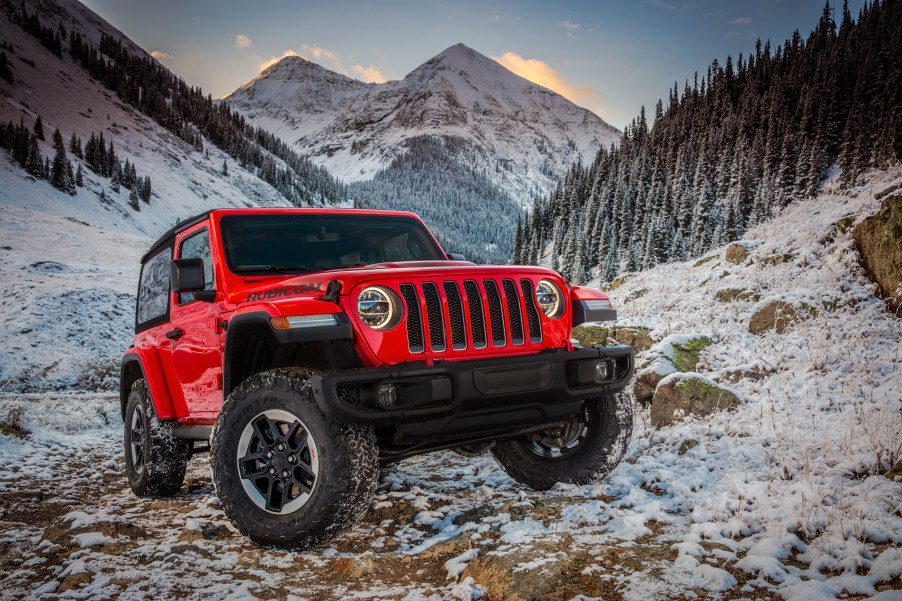
Jeep Finally Has a Fix for the Wrangler Death Wobble
There is little doubt that when it comes to midsize SUVs, everyone has heard of the Jeep Wrangler. The Wrangler has been around in one form or another for decades, and despite an ever-increasing price tag, it remains a popular choice. One reason for its popularity is Jeep Wrangler’s reputation for offroad capability. Being named SUV of the Year probably doesn’t hurt, either. However, the Jeep death wobble sounds silly, but it is real and can be dangerous.
Can you fix the Jeep death wobble?

Jeep and FCA have recently released a service bulletin with a solution for Jeep Wrangler’s death wobble via the Detroit Free Press. It involves a redesigned steering damper that allows fluid to return faster during compression cycles. This solution is being questioned as part of a lawsuit in which Jeep Wrangler owners are seeking answers to the issue. Some are calling the steering damper resolution a band-aide.
So how does a vehicle with all these accolades achieve and maintain its iconic status with a condition commonly known as “Death Wobble?” Here is some more information about the issue and how to act should you find yourself trapped in the wobble yourself.
What is the Jeep death wobble?
Death wobble has been around even longer than the Jeep Wrangler has been in existence. While death wobble does affect other vehicles, mostly four-wheel drives with solid front axles, it seems that the Wrangler’s popularity has led to the term being closely related to the Wrangler name. Jeep’s parent company, Fiat Chrysler Automobiles, FCA, would prefer to call the phenomenon a “vibration” rather than death wobble and are quick to point out that no serious injuries or deaths have been caused by it.
From outside the vehicle, it can look very much like a shopping cart with a bad wheel. It will be easily noticed by surrounding traffic, and hopefully, they will give some space to anyone caught in the throes of death wobble. From the driver’s perspective, it might seem as though the entire front suspension is shaking out from under the vehicle as the steering wheel shakes violently back and forth repeatedly. This can happen at any speed but is most dangerous when it occurs at highway speeds.
What causes this phenomenon on the Wrangler?

Death wobble can result from any one or a combination of suspension and steering component issues ranging from unbalanced tires, loose components, improper alignment of steering components, worn shocks or steering damper, and/or anything bent or broken related to suspension and steering. The popular process of modifying four-wheel-drive vehicles and especially Jeep Wranglers, by adding lift kits with taller/stronger springs and aftermarket suspension components and then driving them through rugged terrain that no normal vehicle would ever navigate is likely the most common factor.
What should you do when a death wobble occurs?
While driving on a paved road, the most common instance that initiates death wobble is hitting a bump or obstacle in the road. This sudden disruption of harmony present between steering and suspension components can lead to violent shaking of the steering wheel. Knowing this will help you prepare anytime you see or feel the potential death wobble instigator.
When you hit that bump in the road, the first thing you should do is make sure you have your hands at the proverbial 10 and 2 o’clock positions on the steering wheel and relax your grip. This will allow the steering wheel to shake back and forth while you gently guide your vehicle without injuring your hands or wrists. Do not panic, and do not try to control the shaking by gripping the steering wheel. It likely won’t work and could cause more harm than good.
The next step depends on the flow of traffic. Speeding up or slowing down a little will often return your vehicle to the harmonious balance it had before the bump. Accelerate if safe to do so, or let off the gas and slow down, do not slam on your brakes. Sometimes a minor change in speed will work, sometimes it won’t. If it doesn’t work, you will need to slow down or maybe come to a complete stop. It’s important to not overreact and gently guide your vehicle toward the shoulder while gently applying pressure to the brake pedal. It may feel like your vehicle is tearing itself apart, but it is not.



